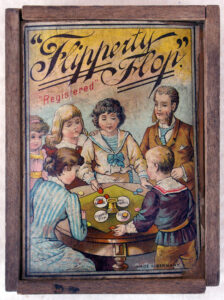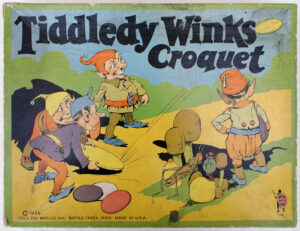Now let us return to 1890. The name of the game quickly fell into the public domain starting in 1890 (though in the United States, Parker Brothers attempted to trademark the name of the game, but was rebuffed by the U.S. Patent Office at the time.).
The golden era of tiddlywinks as a craze, a fad, began and lasted for nearly a decade. Fleet the time carelessly, as they did in the golden world. [William Shakespeare, As You Like It, Act I, I, 126.] But the game was still spelled Tiddledy Winks then, and some still spell it that way even today, even though the definitely preferred modern spelling is tiddlywinks. The tiddlywinks spelling is known to have been used as early as 1892, but wasn’t dominantly common until the 1950s.
The first U.S. tiddlywinks patent, # 432,170, actually was registered by an Englishman, George Scott, who had already patented, in England, a golf version of the game. (The U.S. application was submitted on 6 June 1889 and approved 22 March 1890.)
McLoughlin Bros. • Tiddledy Winks Games
The earliest known and documented American date for a published item actually using the word “tiddledy winks” is on 14 August 1890, when McLoughlin Brothers copyrighted its “Directions for Playing The American and English Game of Tiddledy Winks”. (Tiddlywinks patents did not refer specifically to “tiddlywinks” or “tiddledy winks” until 1925, in the Henry van Arsdale Jr. patent for tiddlywinks golf.) And so what was the difference between the American and English games? That shall remain a mystery for now. An element of intrigue is essential to any pursuit. (Sorry, that is not from Shakespeare!).
![[+template:(Tucker Tw ID • [+xmp:title+] — publisher • [+iptc:source+] — title • [+xmp:headline])+]](https://tiddlywinks.org/wp-content/uploads/2023/01/1890-11-18-patent-by-C-N-Hoyt-num-441099-drawings-scaled-e1722174927643.jpg)
![[+template:(Tucker Tw ID • [+xmp:title+] — publisher • [+iptc:source+] — title • [+xmp:headline])+]](https://tiddlywinks.org/wp-content/uploads/2023/01/1891-06-02-patent-by-C-N-Hoyt-num-453480-drawings-scaled-e1722174820381.jpg)
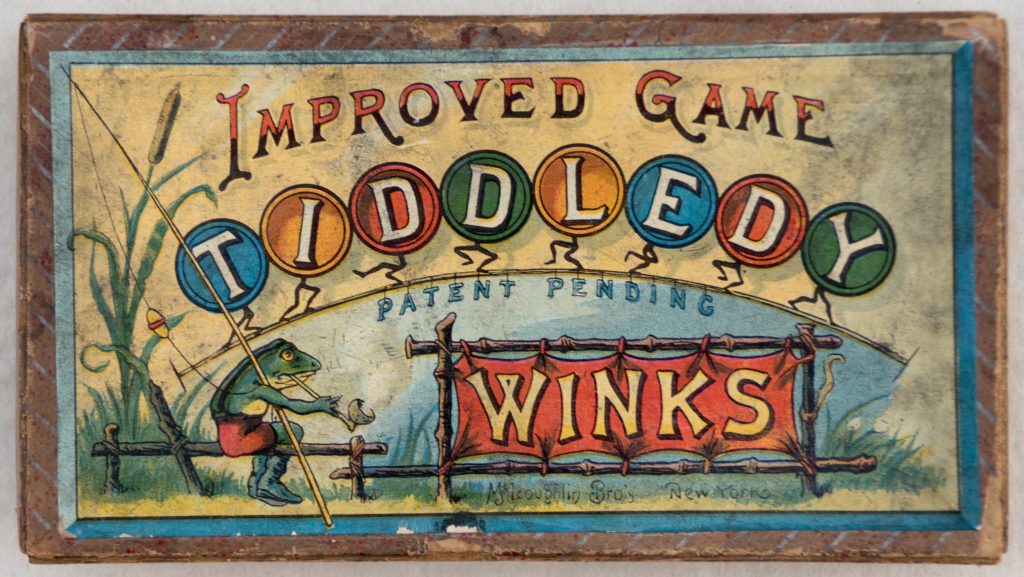
Rick Tucker Tiddlywinks Collection
Licenseable per Creative Commons CC BY-SA 4.0
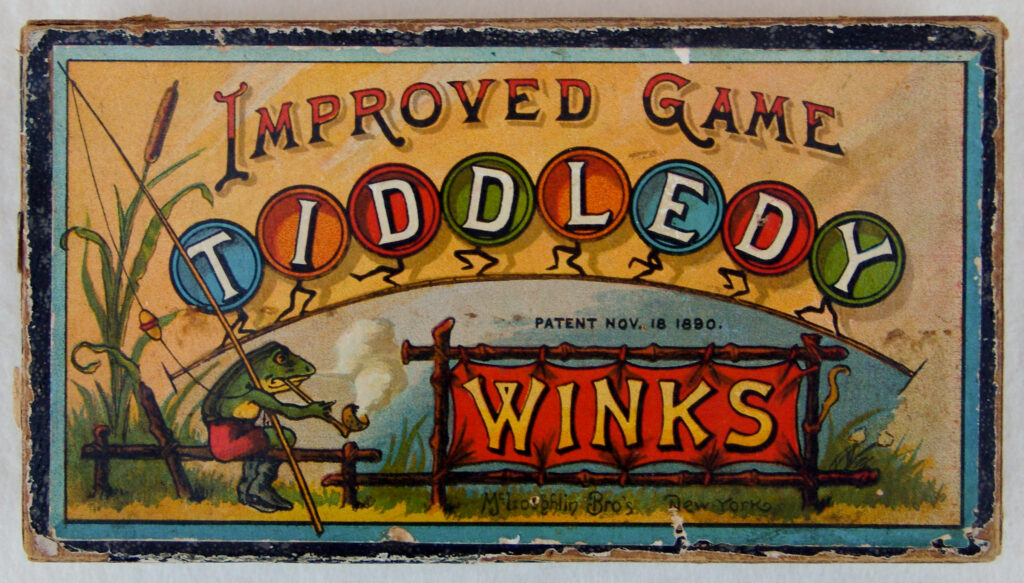
Rick Tucker Tiddlywinks Collection
Licenseable per Creative Commons CC BY-SA 4.0
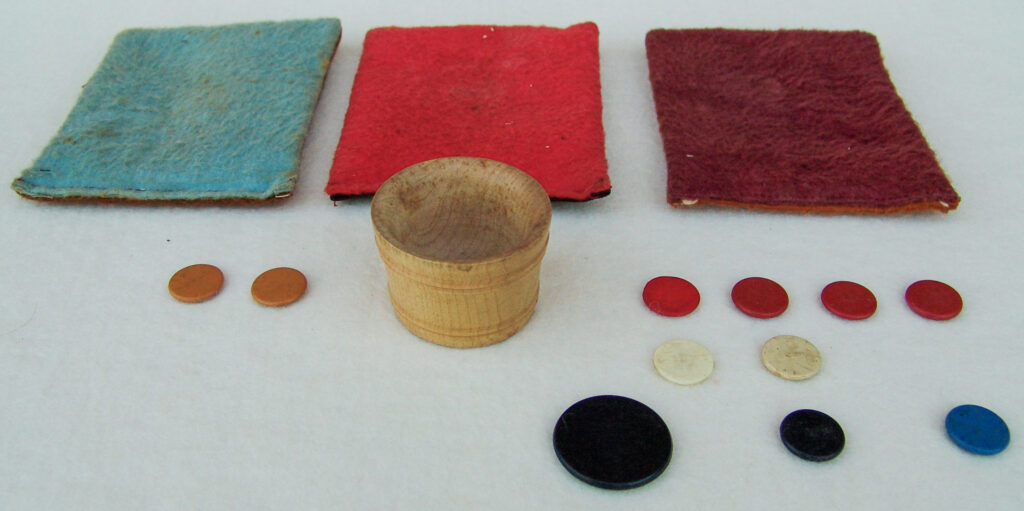
Rick Tucker Tiddlywinks Collection
Licenseable per Creative Commons CC BY-SA 4.0
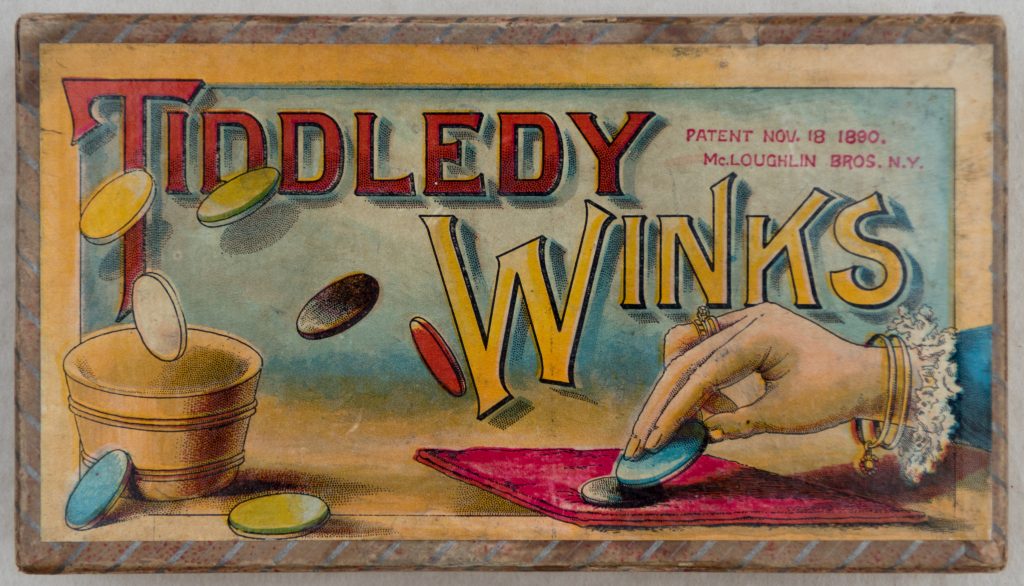
Rick Tucker Tiddlywinks Collection
Licenseable per Creative Commons CC BY-SA 4.0
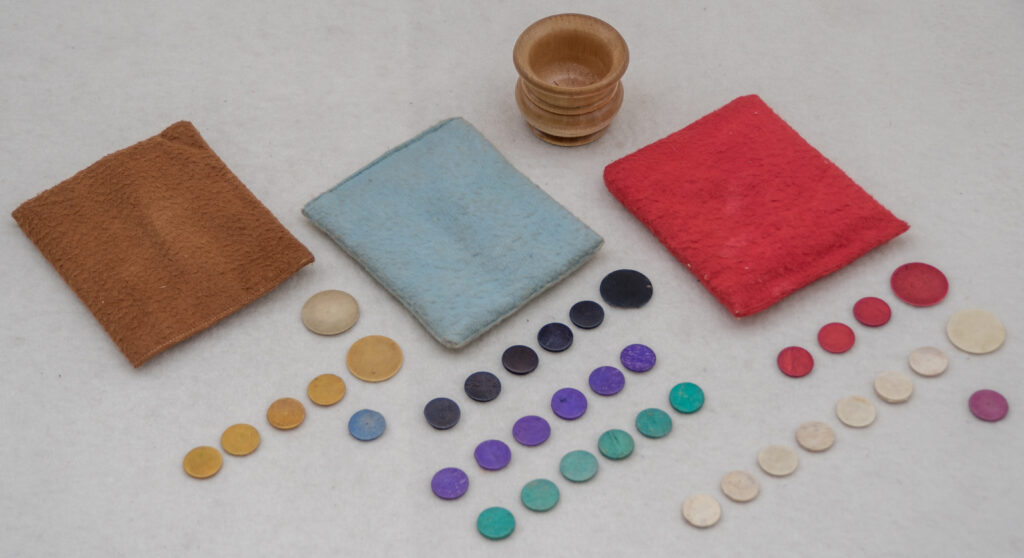
Rick Tucker Tiddlywinks Collection
Licenseable per Creative Commons CC BY-SA 4.0
In the meantime, competition among games manufacturers for newer and better tiddlywinks sets and varieties was becoming quite fierce. In modern winks argot, any variation from the official modern tournament rules is deemed a perversion. The most successful perversions are tiddlywinks versions of sports, such as bowling, tennis, horseshoes, basketball, baseball, etc. (described in a subsequent chapter). The early 1890s saw a patent frenzy to claim unique niches in the tiddlywinks marketplace, plus a few trademarks.
E. I. Horsman • Tiddledy Winks Games
The earliest reports of tiddlywinks innovations appeared in The American Stationer, a trade journal for stationery storekeepers that also sold tobacco products and parlor games. The first notice about tiddlywinks appeared in its 4 September 1890 issue:
"Tiddledy Winks" is the latest game brought out by E. I. Horsman, 80 William street. It is simple and amusing, being, in fact, one of a large class of mirth provoking sports, which are always the jolliest kind of amusement for evening when the family Is gathered under the evening lamp and a running fusillade of chaff and fun is kept going. It is easily learned and is especially adapted for children, albeit older people say that it is full of amusement. Send for Horsman's descriptive game catalog.
The American Stationer, 4 September 1890, page 593.
A NEW GAME. In "Tiddledy Wink Tennis" E. I. Horsman, 80 William street [New York City] has brought out a very pretty and lively parlor game, which will furnish sport for tennis players during the season when they are debarred from exercising their skill in the open air. "Tiddledy Winks," as originally brought out, is full of amusement, but the new game is infinitely more engaging, and besides, it offers a considerable field for the display of nice calculation and skill.
The American Stationer, 18 September 1890, page 691.
Indeed, the son, Edward Imeson Horsman, Jr. (of Brooklyn, New York) clearly thought he had a gold mine here, since he submitted a U.S. patent application for PARLOR-TENNIS on 22 September 1890, which was swiftly approved on 9 December 1890 (# 442,438), and then on 24 September 1890 he copyrighted “Tiddledy Wink Tennis—Rules for the Game”. These would be the last patents, copyrights, or otherwise for tiddlywinks sets in his name, although Horsman did come out with several other editions created by others… as we shall see.
E. I Horsman Jr. was born on 10 March 1873. Hence, when he submitted his patent for PARLOR-TENNIS on 22 September, 1890, he was 17 years old! At that time, he was eight years younger than Joseph Assheton Fincher when he submitted, at the age of 25, his application for a patent for the original game of TIDDLEDY-WINKS.
The E. I. Horsman company was later best known for many years for its line of innovative and popular dolls.
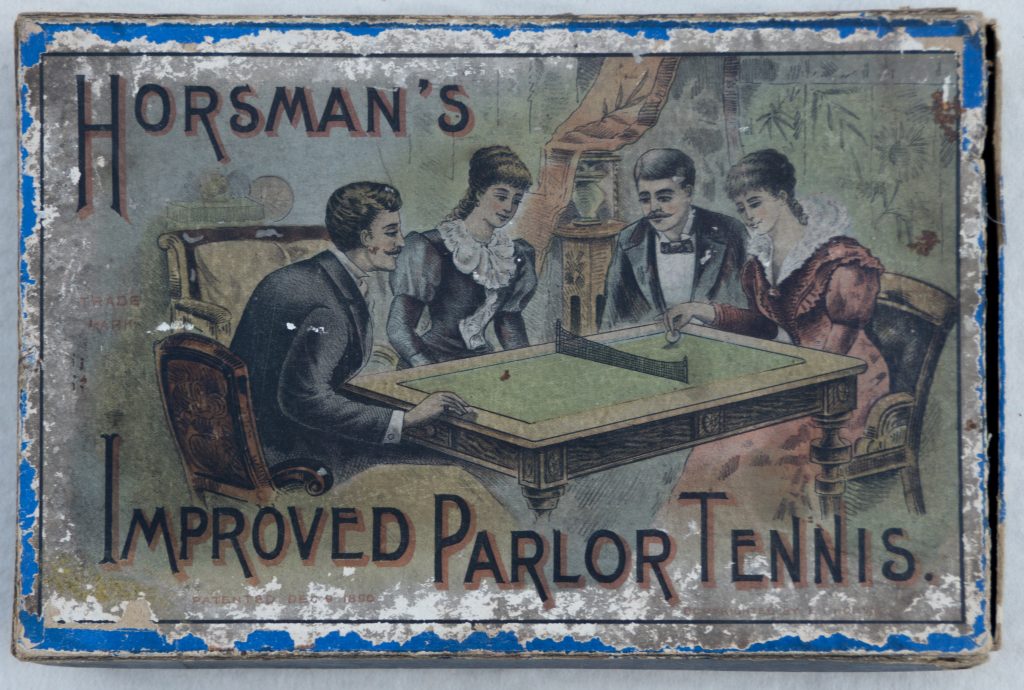
Rick Tucker Tiddlywinks Collection
Licenseable per Creative Commons CC BY-SA 4.0
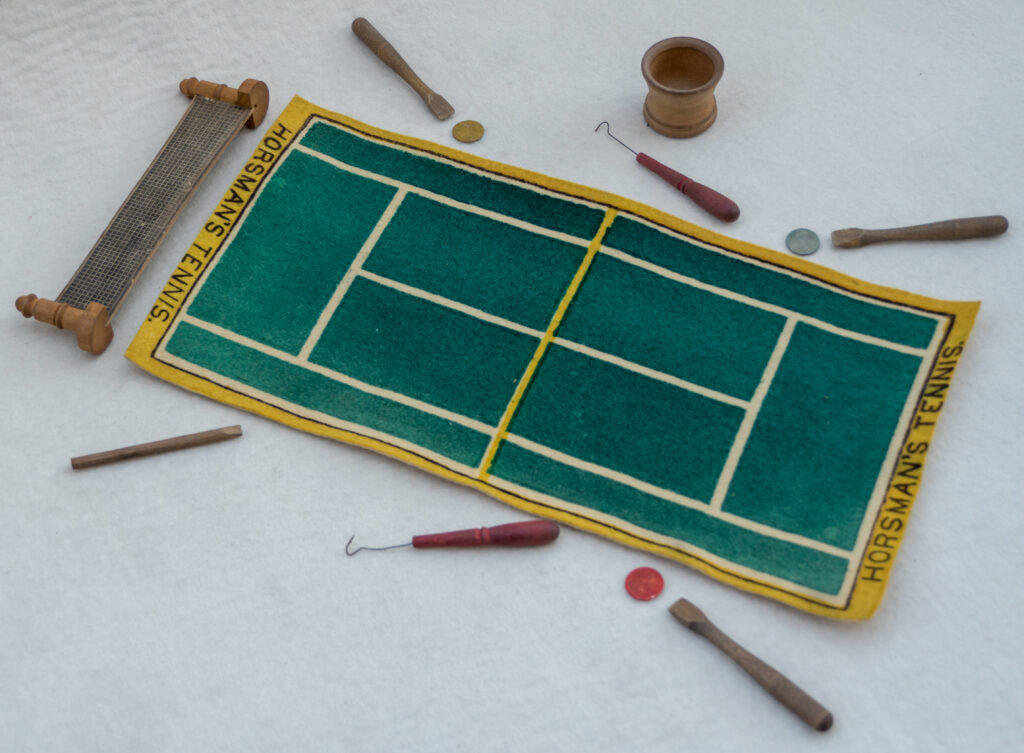
Rick Tucker Tiddlywinks Collection
Licenseable per Creative Commons CC BY-SA 4.0
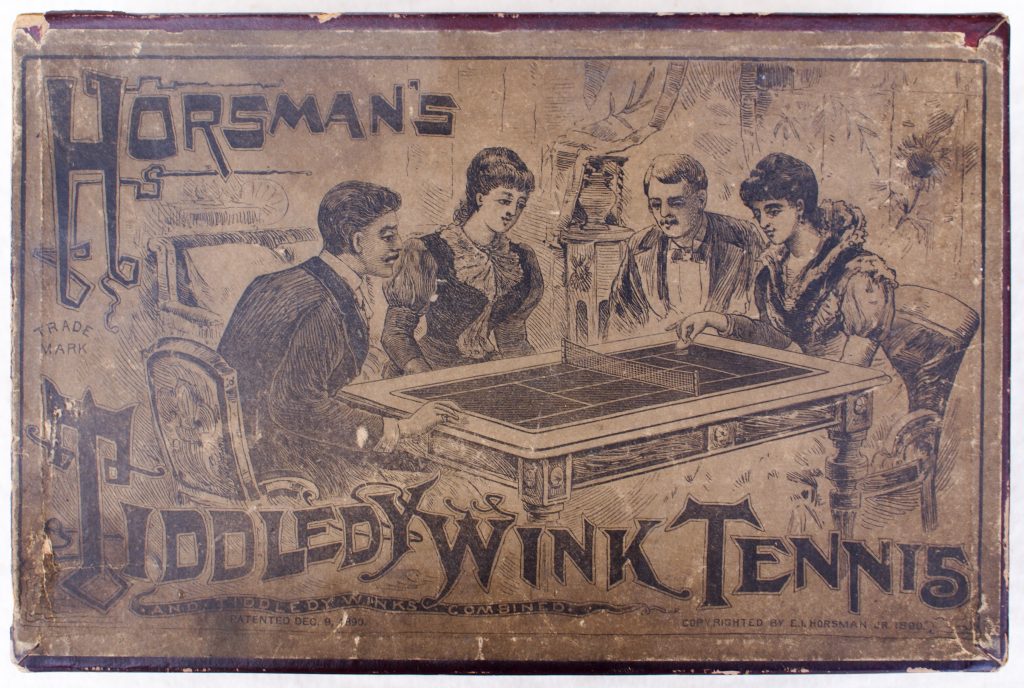
Rick Tucker Tiddlywinks Collection
Licenseable per Creative Commons CC BY-SA 4.0
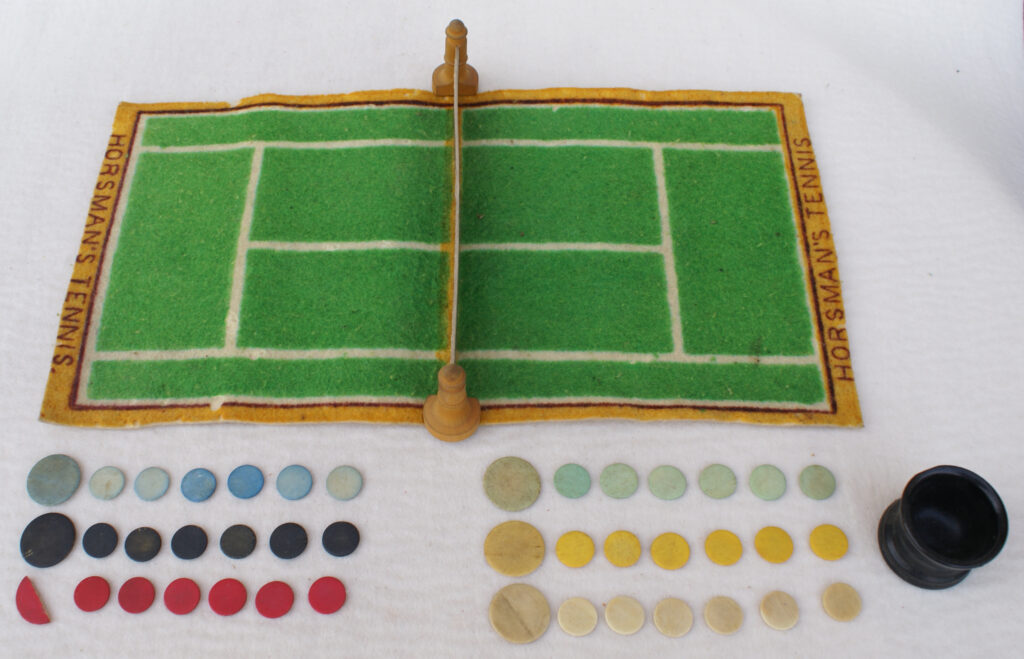
Rick Tucker Tiddlywinks Collection
Licenseable per Creative Commons CC BY-SA 4.0
And on 9 October 1890 in The American Stationer:
E. I. Horsman, 80 William street, is wearing a 7x9 smile these days, notwithstanding he has set the whole world by the ears with his "Tiddledy Winks" tennis, and dealers are fairly tumbling over each other in their haste to get orders in early. […] He cannot manufacture the games fast enough, however, to keep up, and has adopted the plan of sending a dozen to dealers who order a gross […].
This fellow’s wise enough to play the fool, And to do that well craves a kind of wit. [William Shakespeare, Twelfth Night, Act III, I, 68.]
And in the 4 December 1890 edition of The American Stationer:
"See that bundle of letters?" said E. I. Horsman, the great "Tiddledy Winks Tennis" promoter […]. "Well, there are sixty-five of them, every one orders for my favorite game, and they have got to be answered before I go to my dinner […]"."Tiddledy Winks Tennis" is a great thing, I tell you, but I cannot stop to explain why just now. Come again—after the holidays, when the rush is over—and we will confer together on the subject."
The dealers are still worrying the life out of E. I. Horsman, 80 William street, about "Tiddledy Winks Tennis," although it must be said he preserves a wonderfully comfortable appearance and smiling countenance for a man who thinks of "Tiddledy Winks" all day and dreams about it all night. He declares however, that he believes people will go right on buying the game regardless of the close of the holiday season, and he thinks there will be no rest for him until every man, woman and child in the United States has one, and he is afraid that by that time Europe will have heard of it, and he will have fresh troubles trying to understand what they want. However, he does not look as though he would mind a babel of tongues very much if "Tiddledy Winks" was involved.
In the meantime, John D. Champlin, Jr. and Arthur E. Bostwick published The Young Folks’ Cyclopædia of Games and Sports (Henry Holt & Co., New York) which is dated in the foreword as 7 November 1890 and as 1890 on the cover page. This book contains the first TIDDLEDY WINKS rules published in a book in the US. Here are the rules for TIDDLEDY WINKS included in the 1890 Champlin & Bostwick book.
TIDDLEDY WINKS. A game played by any number of persons, singly or as partners, on a table covered with a thick cloth. Each player is provided with a set of six small counters and one large one, all of the same color, the different players having different colored sets. A little basket or cup, generally of ivory or celluloid, is placed in the centre of the table, and each player ranges his small counters in front of him in a line about eight inches from it. The object of the game is to snap each of the smaller counters, by pressing on its edge with the larger one, so as to make it jump into the basket, and he wins who first gets all his counters in. The players take turns, but he who is successful in snapping a counter into the basket has the privilege of playing until he fails. After a player has played out all his counters from the starting line, he can play, when his turn comes, any of his counters wherever it may lie; but he is not allowed to touch any of his adversary's counters, and if any of his own be covered, and no other be available, he must wait until his adversary has uncovered one before he can play. A player may not intentionally cover any of his opponents' counters. If a counter fall off the table, it must be replaced one inch from the edge where it fell off. Partners sit opposite each other, and may play each other's counters after they have left the starting line. Variation. The game may be played with several variations by marking, around the basket on the cloth with French chalk, a ring about four inches in diameter.
Tiddledy Winks may be played also as a PROGRESSIVE GAME, on any number of tables.
- Any counter falling within this ring is to be considered dead, the winner being he who gets most counters into the basket.
- Any counter falling within the ring must be returned to its place in the starting line, and played out by the player at his next turn.
- If a counter fall within the ring, the next or any other player during that round, is at liberty, if he choose, to play it (instead of his own) to any part of the table he may consider best for himself. If it be not played thus, the player to metal conducts heat so well that it whom it belongs can play with it leads the heat away from the card at his next turn in the usual way.
- Mark on the cloth any figure, such as a circle, a square, etc., and divide it into numbered segments or parts. Several games may be played with these, the counters scoring according to the number of the part they fall in.
John D. Champlin, Jr. and Arthur E. Bostwick • The Young Folks’ Cyclopædia of Games and Sports (Henry Holt & Co., New York) • 1890 • pages 725–726
Parker Brothers • Early Tiddledy Winks Games
George S. Parker discovered the fun and new emerging game of Tiddledy-Winks in England, and thought he had acquired from John Jaques & Son in England the exclusive rights to publish the game in the United States. But that was not to be.
One of George Parker's first winning moves had been opening up trade with his English counterparts. [...] When word reached him of the success of a funny little flicking game being played everywhere in Queen Victoria’s country, he grabbed the U.S. rights. The game was called the New Round Game of Tiddledy Winks and was sold by the firm of J. Jacques Jaques and Son. It consisted of a small pot, made of wood or glass, and circular counters made of bone. The aim was to flick each smaller “wink” into the pot by pressing on its edge with a larger counter (“tiddledy” or “shooter”). With a bit of skill and dexterity, even a child could learn to launch the little winks toward the pot from several feet away. The game became one of the first novelty activities to sweep the country. Parker Brothers immediately applied for a U.S. trademark for the name Tiddledy Winks. Fourteen editions appeared in the following year’s Parker Brothers catalog, with prices ranging from twenty-five cents to $1. George wrote proudly of the “continuous hold” the game had on “little ones.” Protecting his hold on its rights was another matter. The trademark did not clear, being deemed generic. During the next few years, while Parker Brothers’ winks were being flicked everywhere in the nation and “made a considerable sum,” Parker Brothers had to share its rewards with many other makers that honed in on the vogue for Tiddledy Winks. Milton Bradley, Selchow & Righter, McLoughlin Brothers, and several smaller firms quickly marketed their own versions of the game that George had purchased in England.
Phil Orbanes, The Game Makers • The Story of Parker Brothers from Tiddledy Winks to Trivial Pursuit, Harvard Business School Press, © 2004, pages 24–25
Principle had guided George Parker well in the past, and the experiences of recent years honed another for him. Principle 3 became “Play by the rules, but capitalize on them.” He first learned this principle by watching the way his competitors capitalized on the Tiddledy Winks fad.
Phil Orbanes, The Game Makers • The Story of Parker Brothers from Tiddledy Winks to Trivial Pursuit, Harvard Business School Press, © 2004, page 30
Tiddledy Winks debuted in Parker Brothers’ 1891 catalog, with an amazing 11 editions ranging in price from 10 cents ($3.12 in 2022 dollars) to $3.50 ($119.19 in 2022 dollars). Various materials were used for the winks and squidgers in these sets: bone, vegetable ivory, celluloid, composition, and wood. Ivory is listed for edition no. 36, though that’s likely to be vegetable ivory rather than real bone ivory.
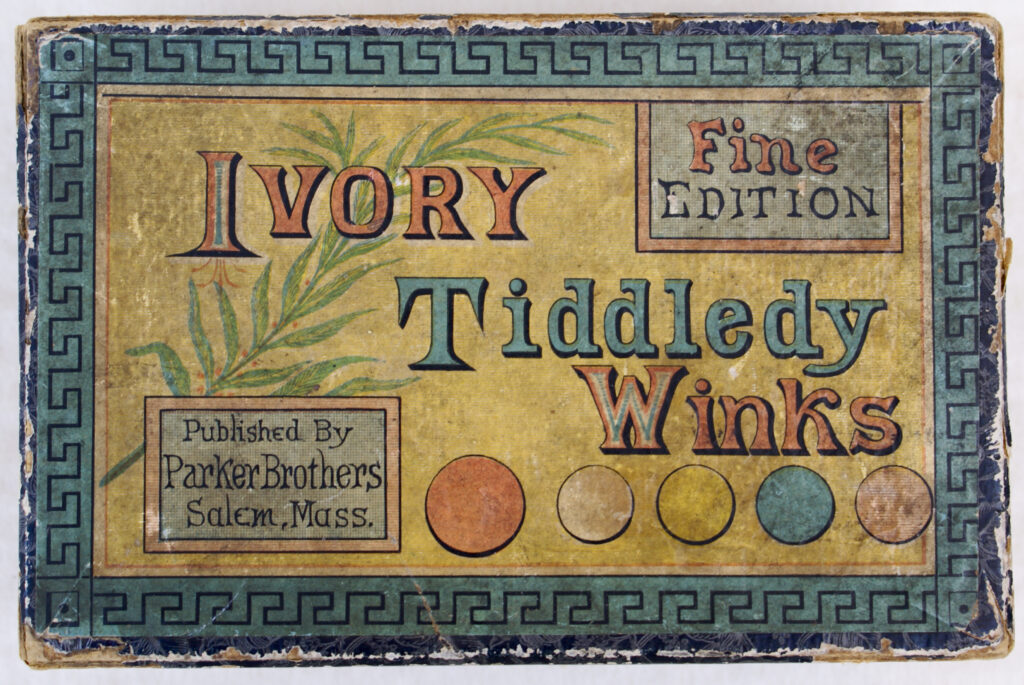
title • IVORY Tiddledy Winks Fine EDITION
publisher • Parker Brothers
date • first published in 1891
item • cover
photograph by • Rick Tucker
original in • Tucker Tiddlywinks Collection
licenseable • per Creative Commons CC BY-SA 4.0
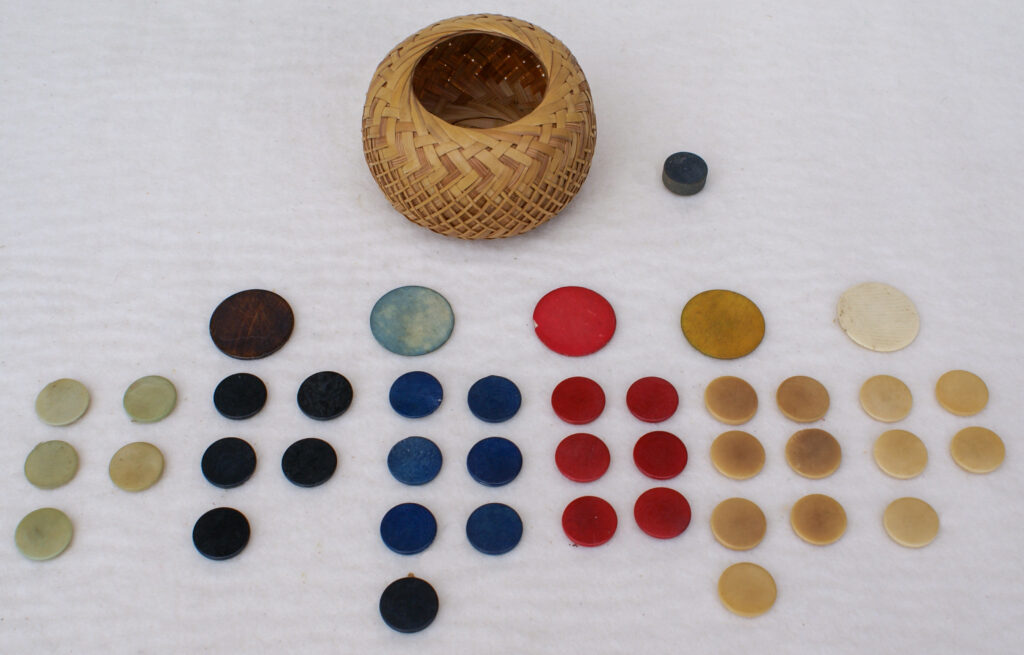
title • IVORY Tiddledy Winks Fine EDITION
publisher • Parker Brothers
date • first published in 1891
item • contents
photograph by • Rick Tucker
original in • Tucker Tiddlywinks Collection
licenseable • per Creative Commons CC BY-SA 4.0
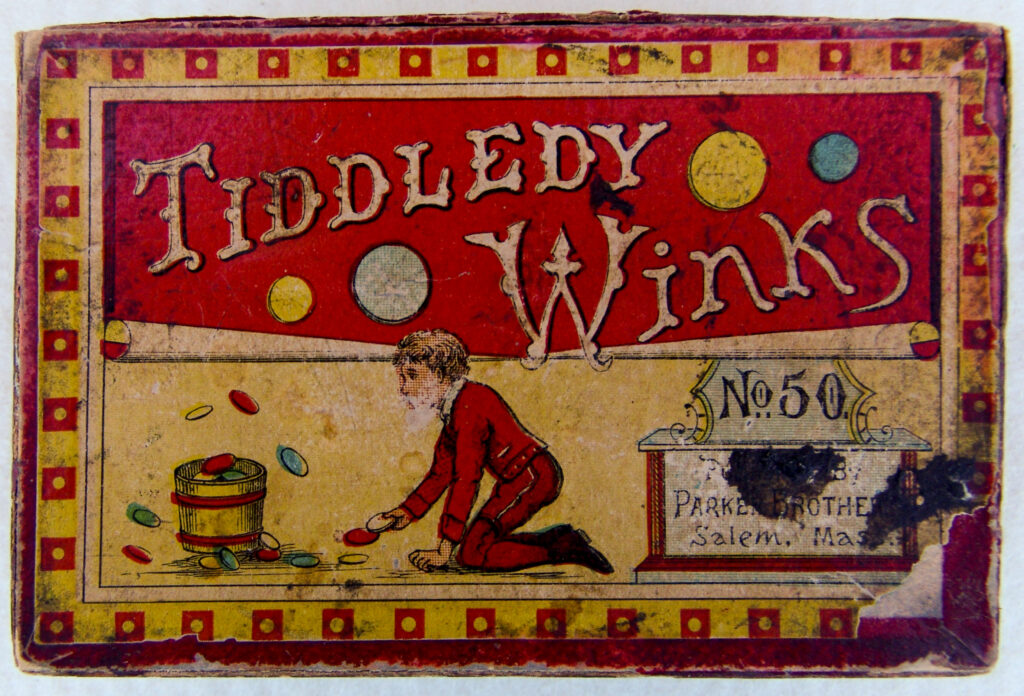
title • TIDDLEDY WINKS
publisher • Parker Brothers
date • first published in 1891
item • cover
photograph by • Rick Tucker
original in • Tucker Tiddlywinks Collection
licenseable • per Creative Commons CC BY-SA 4.0
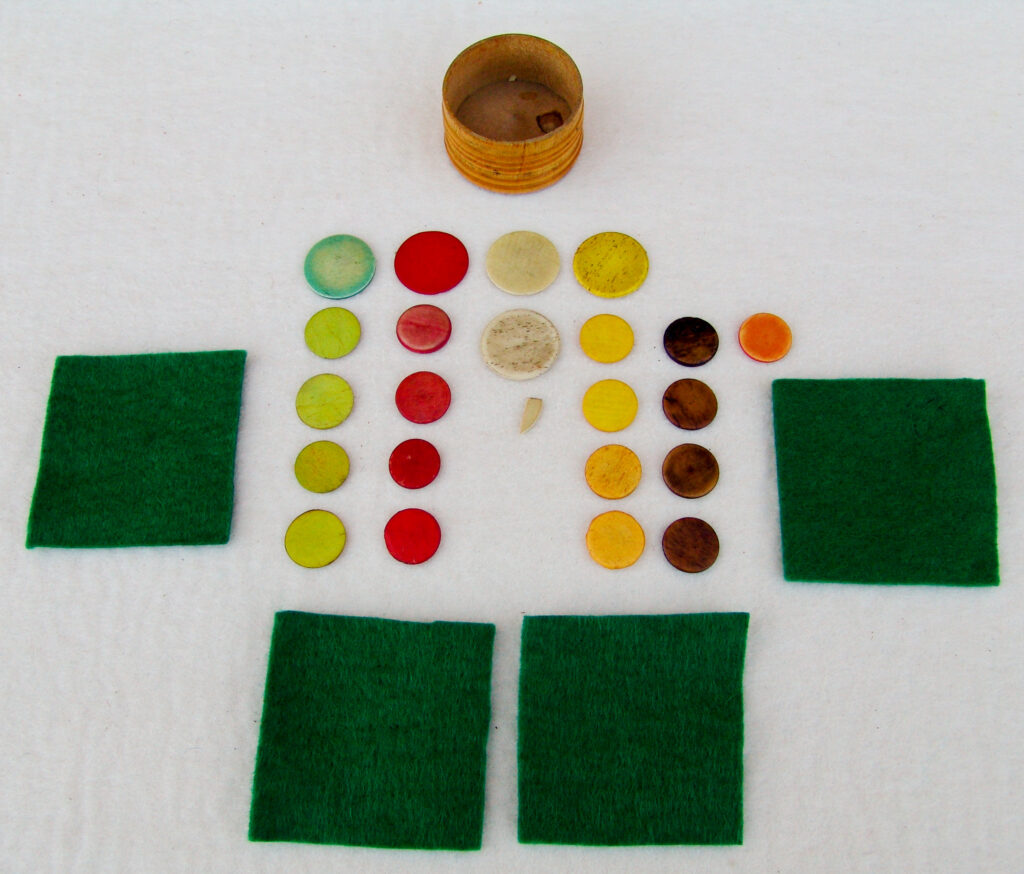
title • TIDDLEDY WINKS
publisher • Parker Brothers
date • first published in 1891
item • contents
photograph by • Rick Tucker
original in • Tucker Tiddlywinks Collection
licenseable • per Creative Commons CC BY-SA 4.0
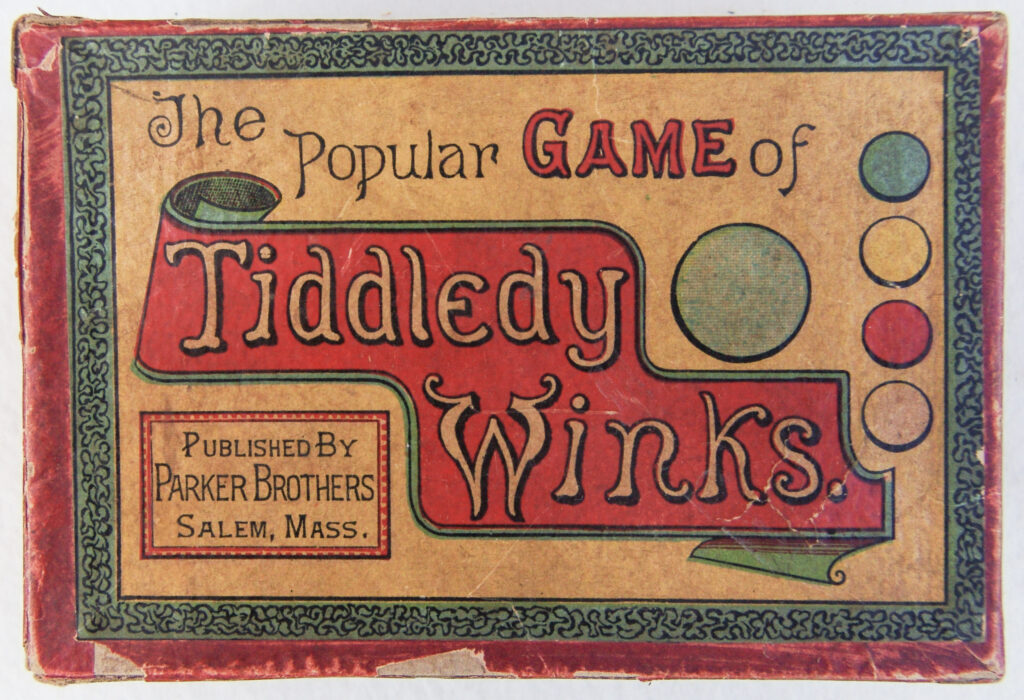
title • The Popular GAME of Tiddledy Winks
publisher • Parker Brothers
date • first published in 1891
item • cover
photograph by • Rick Tucker
original in • Tucker Tiddlywinks Collection
licenseable • per Creative Commons CC BY-SA 4.0
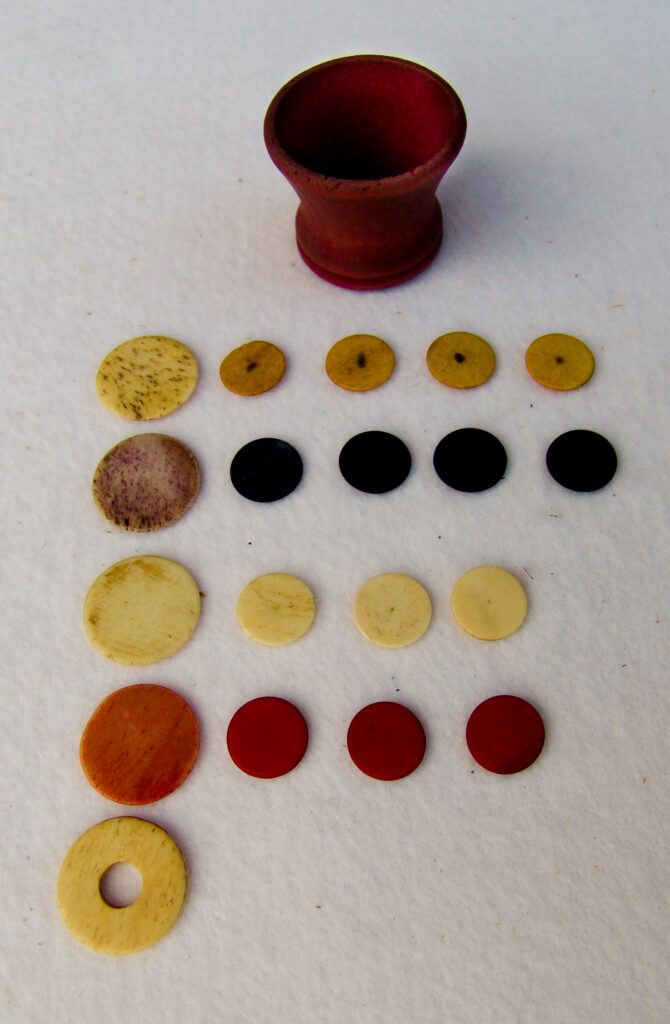
title • The Popular GAME of Tiddledy Winks
publisher • Parker Brothers
date • first published in 1891
item • contents
photograph by • Rick Tucker
original in • Tucker Tiddlywinks Collection
licenseable • per Creative Commons CC BY-SA 4.0
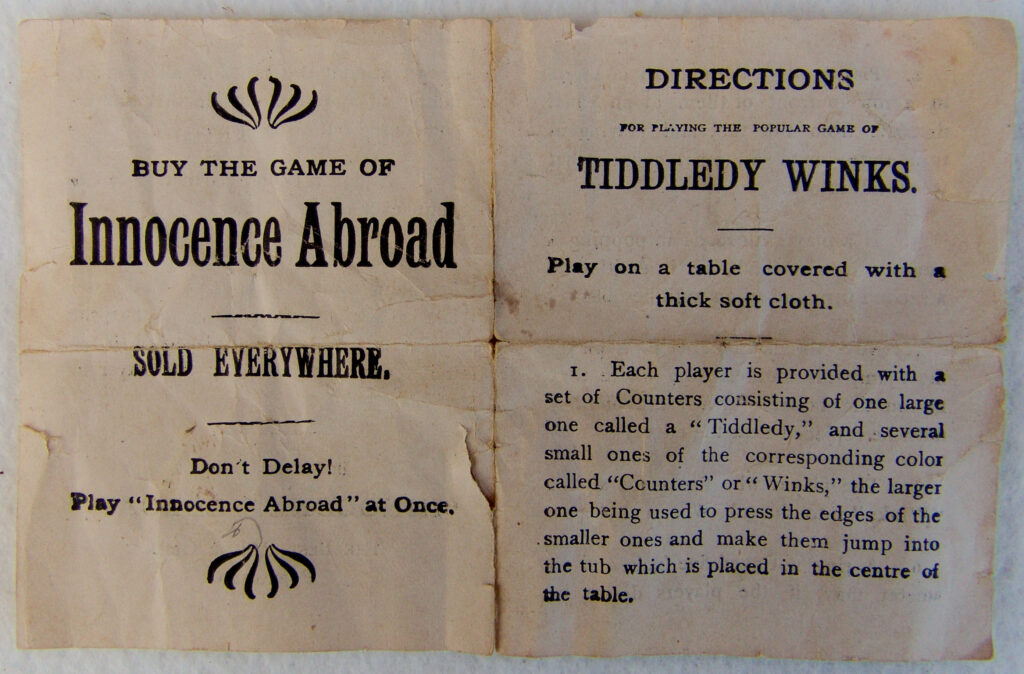
title • The Popular GAME of Tiddledy Winks
publisher • Parker Brothers
date • first published in 1891
item • rules, pages 4, 1
photograph by • Rick Tucker
original in • Tucker Tiddlywinks Collection
licenseable • per Creative Commons CC BY-SA 4.0
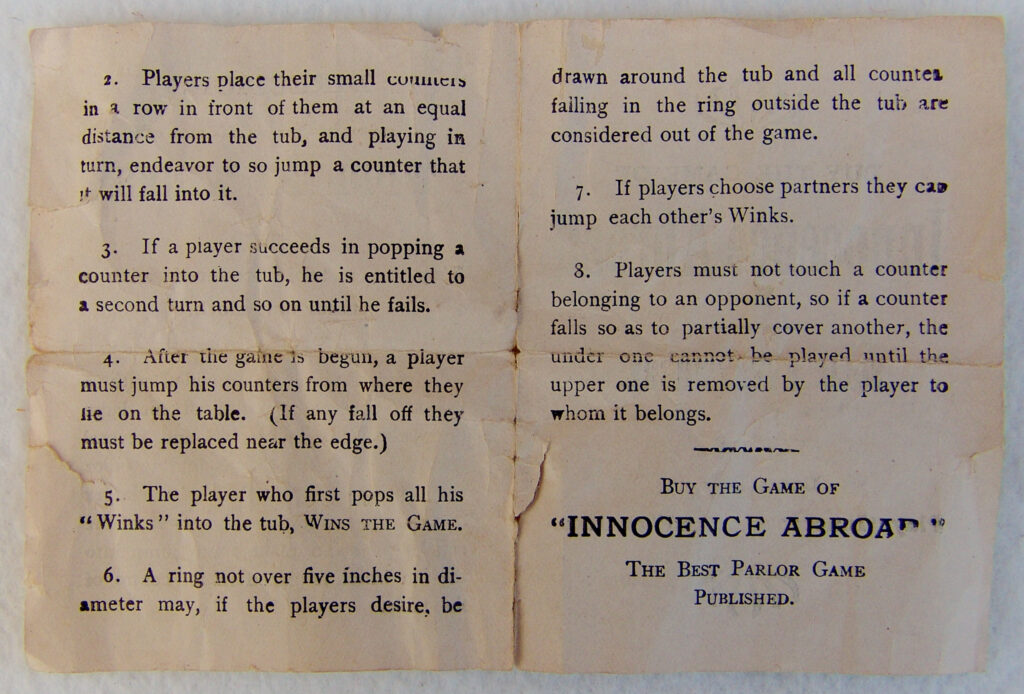
title • The Popular GAME of Tiddledy Winks
publisher • Parker Brothers
date • first published in 1891
item • rules, pages 2, 3
photograph by • Rick Tucker
original in • Tucker Tiddlywinks Collection
licenseable • per Creative Commons CC BY-SA 4.0
Tiddlywinks Patent • by Charles Zimmerling
Some patented targets are invitingly complex, such as those by Charles Zimmerling (U.S. # 477,287, patented 1892) which I hope to find as part of an actual game. It consists of a vertical circular board on which is mounted a “king cup” and 19 “general cups”, plus a chute to a separate cup. Each cup “may be of different tones, which, as is evident, will be pleasantly apparent when the chips strike or enter the same”, according to the patent text.
While no actual Zimmerling editions with this tiddlywinks game target have been located, Zimmerling did indeed copyright a photograph entitled “Propelling the Disc” in 1892, a drawing of the same name in 1893, and a print entitled “The Parlor Target” in 1895. Without having the opportunity to examine any of these images, it remains unclear whether Zimmerling actually produced any tiddlywinks sets for the market. That said, there may remain some hope that Zimmerling tiddlywinks sets may ultimately be svailable for examination.
As it turns out, Charles Zimmerling is best known for having invented the game of Pin-the-Tail-on-the-Donkey, originally called Donkey Party in 1887, also called Tailless Donkey. His original “pin-on” game spawned the development of a wide variety of “pin-on” games in which participants are blindfolded as they attempt to attach something (such as paper depiction of a donkey’s tail) onto the appropriate place on a targeted item (such as a donkey’s body).
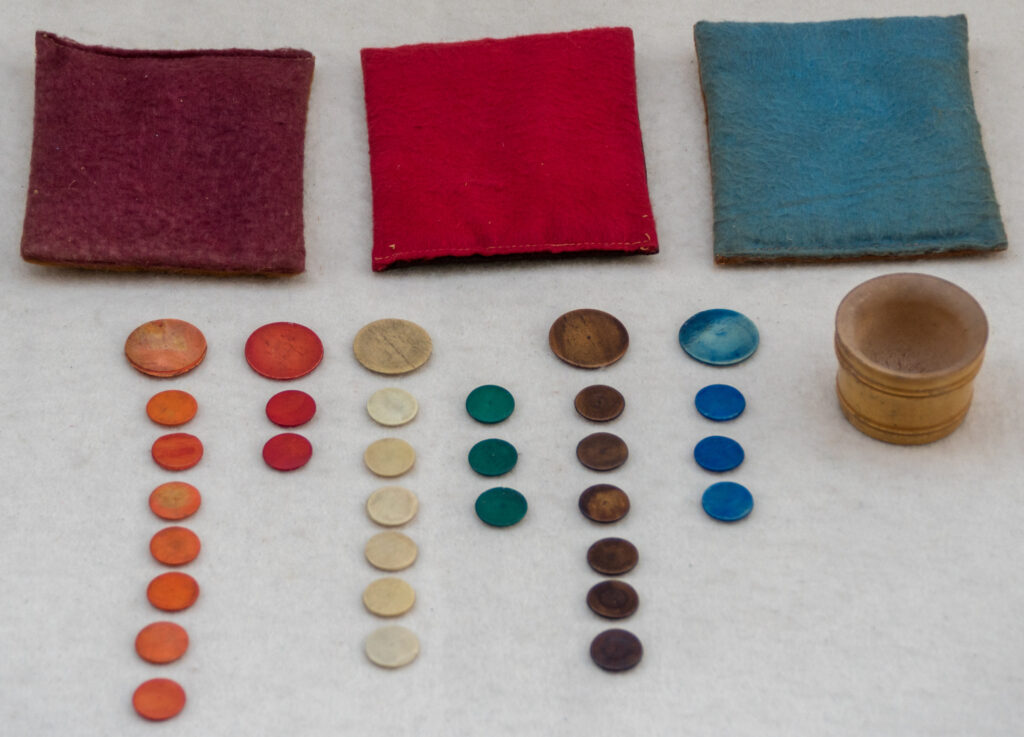
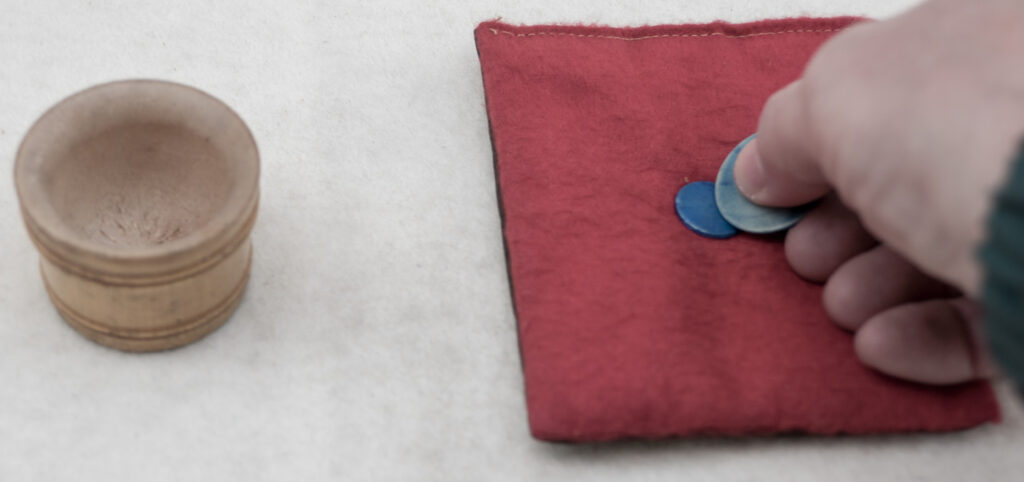
![[+template:(Tucker Tw ID • [+xmp:title+] — publisher • [+iptc:source+] — title • [+xmp:headline])+]](https://tiddlywinks.org/wp-content/uploads/2022/07/US000442438-1-scaled.jpg)
![[+template:(Tucker Tw ID • [+xmp:title+] — publisher • [+iptc:source+] — title • [+xmp:headline])+]](https://tiddlywinks.org/wp-content/uploads/2022/11/1891-Parker-Brothers-catalog-pages-22-23.jpg)
![[+template:(Tucker Tw ID • [+xmp:title+] — publisher • [+iptc:source+] — title • [+xmp:headline])+]](https://tiddlywinks.org/wp-content/uploads/2022/08/1892-06-21-US-paten-477287-by-Charles-Zimmerling-688x1024.jpg)
